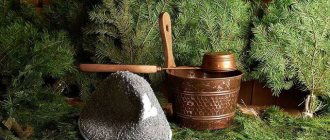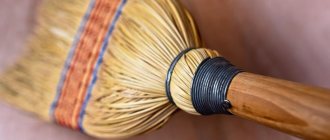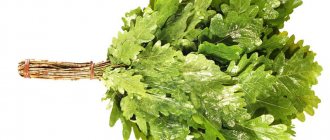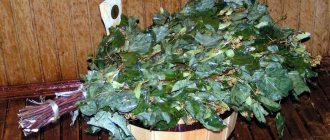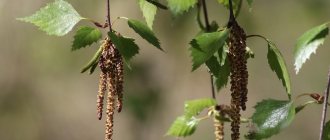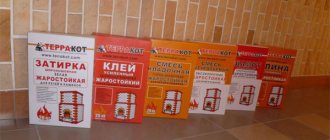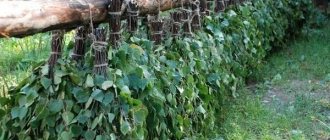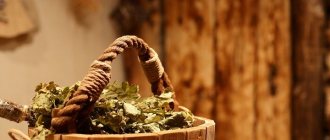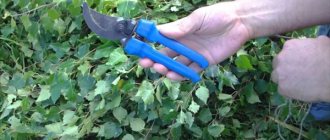Last time we talked about a broom made from birch shoots. Such a tool is good for everyone, but under conditions of active work, it happens that the birch tree begins to lose its leaves. For true connoisseurs of a vigorous Russian bath, an indispensable item in a steam room is an oak broom. Diligent soaring on the top shelves is just about him.
The benefits of oak brooms for the body
Oak brooms have the following healing properties:
- Due to the size and shape of the leaves, they are excellent at generating steam .
- Tannins (catechins) have a beneficial effect on the condition of the skin and are useful for massage.
- Normalizes the condition of oily skin prone to rashes, ulcers and inflammation. Reduces the activity of fat glands.
- They have a positive effect on varicose veins .
- Thanks to the effects of essential oils, blood pressure is normalized in hypertension .
- Oak procedures help get rid of fatigue, relieve tension and nervousness, and have a relaxing effect .
- They have a beneficial effect on the sweat glands, reducing foot sweating .
- Relieves rheumatic pain.
Many ancient peoples endowed oak with magical properties, the ability to ward off evil spirits, help preserve eternal youth, etc. Oak bath brooms, unlike birch brooms, are rougher. They are not suitable for sensitive skin .
Due to the leaves firmly attached to the branches, they are durable.
Using bath brooms
Before using a broom in a steam room, it is necessary to take the following measures:
- leave the broom in water for 10-12 hours;
- blot the branches after water with a damp cloth;
- During the cleaning period, the broom should be moistened periodically.
To use the broom again, you should wash it after the bath procedures and let it dry. This way, not only its original appearance will be preserved, but also the healing qualities of oak branches.
To fully enjoy the steam room and experience all the delights of bath procedures, you need to handle the broom correctly.
Lie on a shelf in a horizontal position, bend your knees slightly and start stroking them with a broom, then stop in the pelvic area. Massage its front and back surfaces several times. Lifting the broom from your hips to your sides and stomach, move to the chest area. Alternately raising your hands, patting your arms and shoulders with a broom. To steam your back and pelvis, you need to turn from side to side. The neck can be steamed while sitting.
Optimal procurement time
The quality of the finished broom depends on the correctness of its preparation and storage. Branches collected ahead of time are too soft and slippery, but those harvested on time are strong and last a long time.
Experienced bath attendants know when to prepare oak brooms for a bath: the custom of preparing them for Trinity has long existed.
Most often, this day falls in mid-June, when the leaves have already grown well and become stronger. It is good to follow folk customs, but when collecting oak branches, it is necessary that the leaves are ripe.
The optimal timing for cutting oak bath brooms just right is determined depending on the climatic features of the area and the weather specifics of the current year. Sometimes the readiness of leafy raw materials (juiciness and size) occurs only in July or even at the beginning of August.
If acorns have already appeared on the oak tree, then the best time has passed , the branches at this time are already too thick and have lost their flexibility. But it is useless to break them into brooms after early frosts.
Attention! The collection of oak branches in different areas is carried out at different times. Before harvesting, you need to check them for flexibility and pliability.
Oak - how much there is in this word
Among the ancient Slavs, oak was revered as a sacred tree and was dedicated to the head of the pagan pantheon, the god of thunder and lightning - Perun. A powerful crown, dense wood, and a deep root system very often provoke the fact that a spreading tall tree simply attracts thunderstorms, and if so, if Perun loves it, then people are simply obliged to honor it. Often Slavic settlements in forested areas were located on the edges of vast oak groves. The light energy of this tree provided the spiritual needs of the family, and the wood met the material needs. Still would! She is good in the hearth, and in construction, and in carpentry, and even in crafts. And today, in the age of high-tech polymers, oak provides a lot of humanity’s needs in a wide variety of areas:
- Oak construction and semi-precious timber is very expensive, but at the same time, a favorite position for carpenters and joiners. Dense solid wood, beautiful texture, developed texture make the wood of this tree in demand at all stages of construction: from laying the main crowns of the bath house to finishing the dressing room with blocks. As for bog oak, not every craftsman can drive a nail into its face - its surface is so strong and unyielding, its characteristic blue-black color;
- Oak acorns are a favorite delicacy of pigs and, oddly enough, gourmets. Yes, some connoisseurs prefer a drink made from acorns even to real coffee, rather than barley or chicory coffee;
- Oak bark is a source of tannins. And if earlier this feature was used by tanners, now it is mainly used by pharmacists. Oak bark is very effective in stopping bleeding in the oral cavity, strengthening the gums, and the walls of blood vessels as well;
- A strong decoction of oak bark can nobly color wood of less valuable species, giving it exquisite charm and depth of visual perception, and ink nuts provide raw materials for the preparation of universal dyes that will color everything: from paper to fabrics;
- In the southern regions of the country, cork oak is feeling more and more confident. Its developed subcortical layer is an indispensable natural raw material for wine and cognac bottles;
- Finally, oak leaves are a very valuable additive when preserving cucumbers. Knowledgeable housewives claim that the presence of oak leaf in the seasoning gives greens hardness, elasticity, and vigor. A truly crisp cucumber can only be achieved with an oak seed at the bottom of the jar.
What is the value of oak in a bathhouse?
Basic collection rules
To ensure that the quality is intended for its intended purpose, when preparing, you must follow the following rules for collecting bath brooms:
- It is best to collect brooms after the dew has disappeared on a warm summer morning in dry weather.
- If it rained before, it is better to wait a few days.
- You can cut branches from trees growing far from roads. Trees no lower than three meters in height with branches half a meter long are suitable for this
- A good sign of the ecological cleanliness of the chosen place is the proximity to succulent burdock trees.
- You cannot cut branches from one tree, exposing it. It is preferable to combine raw materials of different ages, but not younger than two years.
- It is best to choose trees growing in shady and elevated areas.
- Only the side branches are collected and cut off with sharp pruning shears.
After cutting, the branches are folded in a shady place in one layer for an hour. They should be transported carefully. Do not stack them closely to prevent overheating and causing the leaves to fall off.
Interesting! For brooms, branches of both common and red oak are used.
Its leaves are wider, and its branches are more flexible and longer. And the Caucasian oak species has very strong leaves, which is very valuable for bathing purposes.
Linden
The right linden brooms start with finding the right area. Its leaves collect a lot of contaminants when present. Brooms should be harvested from mid-May to mid-June, but before flowering begins. They are knitted and dried similarly to birch ones, but it is advisable not to overdry them. Dried linden leaves are not as durable as birch or oak leaves.
When steaming a linden broom, it is better to dip it in warm water and, after a couple of minutes, shake it off. Then warm it over stones - this way it will be most useful and the leaves will remain strong. A good specimen will last three steam rooms. Sometimes they make mixed linden and birch brooms. In this case, it is better to place linden branches inside the broom, and birch branches outside.
How to dry properly
The tied brooms are placed under a weight for a day so that they become flat and convenient for use. And then they start drying them. The drying rules are:
- The brooms are hung in pairs on a rope in a dark, cool room.
- The drying area must be ventilated so as not to overdry the product, thereby depriving it of its beneficial properties.
- Semi-finished products should not be exposed to sunlight.
- To ensure even drying, the brooms need to be turned over daily.
- The finished product has a pleasant green color and aroma.
- If possible, it is better to dry the brooms in dry and clean hay , stacking them in layers in a stack. With this method, the color and natural smell of the product are better preserved.
Important! If the broom turns out to be too dry, there is no need to discard it. An accessory of poorer quality will have to be steamed longer than successful ones.
BROOMS FOR BATH: PREPARATION, DRYING
When to prepare brooms for a bath?
According to ancient custom, the preparation of brooms for the bath takes place on Trinity Day, which occurs on the 50th day after Easter. Every year this major Christian holiday is celebrated on different calendar days.
It usually falls in early to mid June. The date in 2020 is May 31.
Popular wisdom says that you need to cut brooms for a bath within two weeks after Trinity. At this time it is time to bloom. It's time for grass. Therefore, it’s time to prepare brooms. The leaves in the juice are already strong and give off an aroma.
But experience shows that branches need to be broken when the foliage is ready, because sometimes Trinity falls at the very beginning of June. The climatic conditions of the area play a big role in the harvesting time.
Birch – 2-3 decades of June, until catkins appear on birch trees. When to harvest birch brooms can be determined by the birch leaf. The upper side of the leaf should not be rough, the leaf should be soft and velvety. When a leaf on a birch tree has grown strong enough, so that when you pull it, not all of it flies off, but only part of it
Oak - July, occasionally the very beginning of August. Oak brooms are prepared as soon as the leaves have grown strong, throwing off the young greenery. The earlier the oak broom is harvested, the more delicate the foliage and, accordingly, the less strength. Acorns on an oak tree are a sure sign of harvesting too late.
When and how to cut branches?
The time at which brooms are harvested determines their quality and shedding of leaves, the softness of the branches and their aroma. A broom picked early will be slippery when steamed and the foliage will be fragile. A properly prepared broom lasts a long time and, as steamers say, “holds the leaf.”
Branches should be cut in dry weather. Moistened by rain or dew, the leaves deteriorate when dried, darken, fly off and curl. Therefore, if the weather is rainy on Trinity Sunday, they do it a few days later.
Raw materials for brooms should be cut in environmentally friendly places, away from major highways. Brooms are broken in the first half of the day, after the dew has disappeared. Such brooms will last as long as possible. The best are considered to be biennial branches that grow closer to the ground. The branches are cut with pruning shears 50-60 cm long.
Collecting bath brooms at the beginning of summer is completely justified, because the leaves of the trees have already become large, but they still have enough essential oil glands, which are abundant not only in the leaves, but also on young shoots. Large young shoots are very elastic, so it is pleasant to whip the body with such a broom in the steam room.
How to knit brooms for a bath.
Some people do not tie the broom in advance, but make a kind of sheaf from chopped branches. The upper branches protect those inside. And on top it all is wrapped in hay. This sheaf is stacked in the barn. I got ready to go to the bathhouse - I pulled out the required number of branches from the sheaf and tied a broom.
If you decide to stock up on brooms, then knitting them should take place in a certain sequence. The cut branches need to be spread out for a couple of days, with burlap placed under them. You can knit a broom from withered branches.
Techniques for tying a broom: 1 - laying branches, 2 - applying a cord, 3 - wrapping the handle, 4 - tightening, 5 - tying a knot, 6 - tightening the knot, 7 - pruning, 8 - storing finished brooms.
The sizes of bath brooms vary, some like large brooms, some like small ones, but in any case, the length of the broom should be from 40 to 80 cm, otherwise it will be inconvenient to use.
First, you need to clear the branches of twigs and leaves in the place where the broom handle will be, about a third of the entire length, and collect them together, giving the broom a flattened shape. Place thicker branches inside - they will serve as a frame. Thinner branches are laid around this frame, bending inwards. The branches need to be folded so that the leaves look in one direction when folded and the branches lie in a fan. Then, when used, the broom will “hug” you, as it were. So you get a dense, thick, regular birch broom. You can steam like this for 2-3 baths.
Next, we make a handle: the collected branches should be wrapped with twine at the handle, squeezing them with your left hand. Carefully trim the end of the broom handle and wrap it with a strip of fabric so that you don’t get calluses on your hands in the steam room.
It is best to leave a fairly long handle on the broom (about 15 cm) and tie it tightly in several rows, closer to the foliage, not along the entire length, as many do, but leaving the end of the handle free. So it turns out to be expanded, radiant.
Holding such a broom in your hand is a pleasure. It was as if he had become fused with the palm. Doesn't slip out even with the most vigorous movements.
When preparing brooms, we highly recommend putting sprigs of fragrant herbs into them - chamomile, mint, thyme. You can add sprigs of black currant - the smell is amazing! If the broom contains spruce, pine, nettle, and alder, then prickly or burning branches should be placed inside the broom to prevent “stings.”
And the last rule: The broom should not be made heavy, it should be light and comfortable for the hand. The handle should not be too thin or thick. Here a measure is needed - then you “work” with it.
How to dry brooms correctly?
There are many ways to dry brooms, but there is a mandatory condition that applies to everything: they must be dried in the shade. In the sun, the leaves curl and quickly burn out. From the sun's rays, everything that is fragrant and volatile is carried away into the air. The leaves lose color, aroma and fly off. After the first steaming, such a broom will leave all the leaves in the basin.
It is also not recommended to dry brooms in a strong draft. The drying area should ideally be dark, cool and dry. Dry brooms by hanging or folding. The brooms must be turned over every day so that the branches dry evenly.
Drying a broom, in which it is hung under a canopy on an ordinary rope or on poles so as not to be exposed to direct sunlight, is the simplest. At first they are tied loosely so that they do not fall apart.
It is best when the brooms take the shape of a fan rather than a broom. To do this, after 6-7 days, as soon as they begin to rustle, they are tightly tied and laid tightly, pressing against each other, as a result of which they gradually flatten, taking the shape of a fan and then put away for storage, turning over from time to time.
A properly dried broom will always have matte green leaves, and the broom itself should smell like balsamic oil. This smell intensifies sharply after steaming the broom.
A method of drying brooms in a haystack is available to residents of villages and hamlets. To do this, the hay from which the stack was made must be fresh and dry. Brooms are placed in a stack in layers in a circle, the leaves of the broom are directed towards the middle of the stack, alternating them with layers of fragrant hay. When dried in this way, the broom perfectly retains its shape, color, aroma and maximum beneficial properties.
It happens that the brooms dry out. Don’t be upset and don’t discard it, adjusting the broom is possible. This broom should be steamed for a longer time and then placed on the heater. The steam emanating from the stones will quickly return the broom to normal. After this procedure, be sure to remove fallen leaves from the stones.
How to store a broom.
Having prepared brooms, the main thing in the future is to preserve them correctly, skillfully and carefully. Brooms should be stored in the shade, in a dry and well-ventilated cool room (this could be an attic, barn, garage). Otherwise, the leaf becomes discolored, turns yellow, and loses its freshness and aroma.
It is very useful to store brooms in hay: this way they absorb even more nutrients and become even more fragrant. And in the city they can be stored in paper or plastic bags, as well as in vacuum packaging.
Frozen brooms.
Today, many bathhouses offer to use not ordinary brooms, but special ones - freshly frozen brooms in vacuum packaging. When harvesting, the branches are subjected to shock freezing according to the same principle as vegetables. Thus, the broom retains all the beneficial substances and odors.
The idea of such a bath broom from the freezer was borrowed from the Finns. Whether you adopt this Finnish invention—sauna brooms—into your sauna life or use homemade brooms is up to you.
Mistakes when preparing brooms.
When a broom “goes bald” after repeated use, this can still be understood. But it also happens that at the first use, all the leaves instantly fly off, as soon as you steam it. This can only mean one thing: some link in the “technological chain” of making the broom has been broken.
So, what are the most common mistakes we make when making brooms?
- We can make a mistake in time and prepare branches for a broom too early, when the leaves have not yet become stronger, or too late, when they are no longer held so tightly to the branches. The best period for harvesting branches is until mid-summer. In June, the leaf is already quite dense and holds tightly. And from about mid-July, all deciduous trees begin to prepare for autumn, so that already at this time the leaf becomes weak, and the broom collected during this period will turn out to be “liquid”.
- The second mistake is also very common. In an effort to quickly dry the brooms, some people hang them in the sun. The brooms, of course, dry out instantly, but this causes all the leaves on them to curl into tubes, and as soon as you pour boiling water over such a broom, all the leaves instantly separate from the branches and remain floating in the basin. In fact, you should never dry brooms in the sun. The broom should gradually dry on its own, constantly being in the shade.
- The broom that was prepared immediately after the rain gets exactly the same unpleasant qualities. Also, you should not wait for the leaves to be washed away by rain from dust, nor wash them yourself at home in the bathroom. And if you are really worried about what kind of dust settles on your future broom, then wait until the steam room and then scald the broom with boiling water, all the dust will be washed off in one moment.
How and where best to store
The finished brooms will dry well in a week, then they can be stored on racks in a room with good ventilation.
A dry dressing room or barn is suitable for this. You can also lay them on the floor, turning them over daily for ventilation.
An excellent storage location is a dry attic. It is best to place well-dried hay under the brooms.
City residents can keep bath accessories on a balcony , loggia, basement or in a frost-free garage. It should be cool, not damp, and it should be possible to ventilate them.
Brooms are placed in paper bags and cardboard boxes. The most modern methods of storing them are vacuum packaging or dry freezing.
If stored improperly, the products turn yellow, their appearance changes and their unsurpassed aroma disappears. If all the above rules are followed, the products are suitable for two years.
Combined brooms
For true connoisseurs of the Russian bath, we offer combined brooms made from oak and birch branches, nettles, St. John's wort or other medicinal plants.
Such brooms have an expectorant effect, a good diaphoretic, sedative effect and a unique aroma.
Using a combined bath broom or only one made from oak branches will allow you to maintain good health and youth for a long time.
You can order the finishing of a Russian bath or Finnish sauna on our website or by calling: 8 (499) 110-97-56.
Basic errors during procurement
Inexperienced harvesters who do not know how to make a broom for a bath from oak make the following typical mistakes when collecting and preparing oak branches:
- They are cut off either too early or too late. Raw materials prepared ahead of schedule are too brittle with small leaves. When harvested late, the branches are old, rough, and difficult to bend. The best time to cut brooms is mid-summer.
- Drying the product in the sun. In this case, the process is completed too quickly, and as a result, the leaves lose their shape, color and smell. Proper drying should take place in a cool, ventilated and shaded place.
- Harvesting in damp, rainy weather or immediately after the rain stops. Wet leaves do not dry well and may become moldy. When prepared correctly, they should be completely dry.
Important! If all rules for collecting, drying and storing raw materials are followed, the healing properties of oak and its unsurpassed aroma, intensified during the bath procedure, are preserved for at least 2 years
Oak and bathhouse
As we have already said, oak wood is the most valuable raw material for construction and ornamental timber. However, not every owner will be able to afford to build a bathhouse on his property from solid oak blocks or decorate a recreation room with panels made from this noble wood.
In the oven
Also, not every owner of a steam room will allow himself the luxury of heating a stove exclusively with oak logs. Although, oak is exceptionally good in the oven:
- Its wood has a high calorific value.
- The logs burn with an even, moderate flame and practically do not shoot sparks, like the same spruce firewood.
- It's a pleasure to split oak. Yes, cutting it across the fibers is not an easy task, but lengthwise, even with little effort, it pricks well, and being well frozen, one might say, it’s even fun.
- Oak is not inclined to clog chimneys with soot plugs, the fight against which is a very unusual matter. Even when not completely dried, it does not produce soot as much as other tree species, especially conifers.
- Finally, heating the bathhouse with oak wood immediately creates an indescribable atmosphere of some special comfort and an amazing spicy aroma. Yes, of course, it’s nice to heat a sauna with birch, alder, and fruit logs, but oak is damn good in its own way. Anyone who has used it will definitely confirm.
How to steam it correctly so that the broom doesn’t fly around right away
Steaming a broom before going to the steam room is a mandatory procedure. Then he will more fully release his beneficial substances in the steam room. There are several methods for preparing a broom:
- Keep in cool water for two dozen minutes, and then transfer to hot water for a couple of minutes. During this time, cover with a basin so that the broom softens well.
- Place first in boiling water for a couple of minutes, and then on the bath stones, but make sure that it does not burn on one side; to do this, turn it evenly. And then repeat it all over again.
- If the broom is too dry, then this procedure will need to be done longer than usual.
- In the morning, soak it in hot water for ten minutes, then dip a rag in it and wring it out. Wrap the broom in fabric and put it in a plastic bag before the steam room. And in the bath, put it in a bucket of hot water for a few minutes.
A well-prepared bath attribute exudes a special aroma. After the steam room, the broom should be rinsed with warm water and then hung on a rope to dry .
Attention! There is no need to pour out the water remaining after steaming the broom.
If you moisten hot bath stones with it, the oak aroma in the steam room will intensify.
Methods of application
In order for a broom to last longer, you need to know how to use it correctly and prepare it for bath procedures. To do this, you need to perform several steps:
- Immerse the bundle in warm water for 30 minutes.
- Warm it over warm stones for 30 seconds.
- Immerse the product in cold water for 15 minutes.
After preparation, you can start steaming.
How to steam: basic methods
It is best to visit the steam room together; one of those steaming should lie down, and the other should hold the broom with his hand in a mitten so as not to get burned . When using this attribute you need to remember:
- It should be wet, for this it is good to place a bucket of warm water in the steam room.
- You should not make sudden movements with the fan, so as not to injure the skin.
- If the temperature in the steam room exceeds 60 degrees, then the steam from a high broom can cause burns.
The technology of the health procedure consists of the following stages:
- Massage helps improve blood circulation and normalizes metabolism. First, the body is stroked from the feet to the head in one direction and the other several times: first from one side and then from the other.
- Compress. The fan captures the steam and it falls onto the lumbar region for a couple of seconds. This procedure helps with injuries, muscle pain and sciatica.
- Stretching. It is practiced for sacral pain. To do this, use two brooms. They are first placed on the lower back, and then one is moved to the back of the head, and the other to the legs. All these movements are repeated several times. They should be slow, the broom should not be lifted at all, and if a burning sensation occurs on the skin, it should be cooled in cool water.
- Quilting. With quick and light movements, the end of the broom is rubbed over the back and rear parts of the body for a minute. Then they are quickly stroked. The same is done for twice as long when shifting onto your back.
- Whiplash. With this procedure, greater steam capture occurs when the fan is raised high. Every 2-3 such movements are combined with a compress (stage No. 2).
- Plowing. It is carried out by lightly touching the skin with a broom.
- Shaking. This is a strong heating of the body, alternating with its cooling with the help of a fan, which is first lowered into cool water. First, raise the broom high, and then press it for a couple of seconds to different parts of the body.
- Trituration. During this procedure, using the palm of your hand, pressing on the leaves, rub the body in different directions, and rub the legs and arms only lengthwise.
You need to sit down and stand up after a set of procedures slowly and carefully, for fear of dizziness.
Carefully! The steam room is contraindicated for people with various diseases. In each case, the duration, intensity and temperature of this bath procedure are individual. Before doing this, you must consult a doctor.
Indications and contraindications
Indications:
- disruption of the musculoskeletal system;
- muscle tension;
- prolonged stress;
- colds;
- respiratory tract pathologies.
Contraindications:
- pregnancy, breastfeeding;
- epilepsy;
- mental disorders;
- chronic diseases during exacerbation;
- active inflammatory processes;
- skin damage;
- malignant neoplasms;
- disruption of the cardiovascular system.
If after visiting the steam room your health worsens, you should immediately leave the bathhouse and call an ambulance.
Good alternative
Bath brooms can be different:
- A birch broom is considered the best. It is flexible, light and comfortable, useful for various pains, releases substances that calm the nervous system and purify the air in the steam room.
- Maple broom has high medicinal properties , since the leaves are rich in alkaloids, vitamins and catechins. They help neutralize harmful substances and have tonic and analgesic properties.
- Willow branches are the best remedy for osteochondrosis and relief of pain in the lumbar region.
- Bird cherry broom has bactericidal properties and a subtle almond aroma.
- Eucalyptus brooms are irreplaceable for colds, injuries and joint pain. This is also inhalation. They are often combined with oak or birch.
- Coniferous brooms differ favorably from deciduous ones in that they are harvested year-round. They are contraindicated for people with sensitive skin. Resin or pine resin is useful for rheumatism, respiratory problems, and helps improve skin health. To get rid of pain, just lie on pine paws in the steam room. This is inhalation and massage at the same time.
Other types of bath brooms are also used, and mixed, universal versions are not uncommon.
Sprigs of medicinal herbs are also placed there. In any of these cases, a healing and hardening procedure is provided.
Also, don’t forget about the bamboo broom. This type is not a traditional bath accessory, but it is very good for massage procedures.
A Russian bathhouse with a traditional steam room and a massage with an oak broom - what could be better for your health! This is a remedy for blues and stress and an excellent hardening procedure. But not everyone can do it; there are a number of contraindications for a steam room.
Within reasonable limits, after consulting a specialist, almost everyone can afford bath manipulation with a healing broom.
What are the benefits of bamboo brooms?
Thin bamboo branches relieve fatigue in the body and help normalize blood circulation. Such attributes will help remove stagnant salts from the body and restore a pleasant appearance to the skin. Bamboo brooms are recommended to be used for overwork, cellulite and excess weight, as well as for the prevention of varicose veins.
In general, these products:
- increase skin tone;
- strengthen the walls of blood vessels;
- increase capillary blood flow;
- relieve swelling in the legs;
- remove toxins;
- fight stress.
Since bamboo sticks are durable and at the same time very flexible in structure, they are convenient for massaging the feet, which helps improve the functioning of all internal organs. About other useful properties here.
